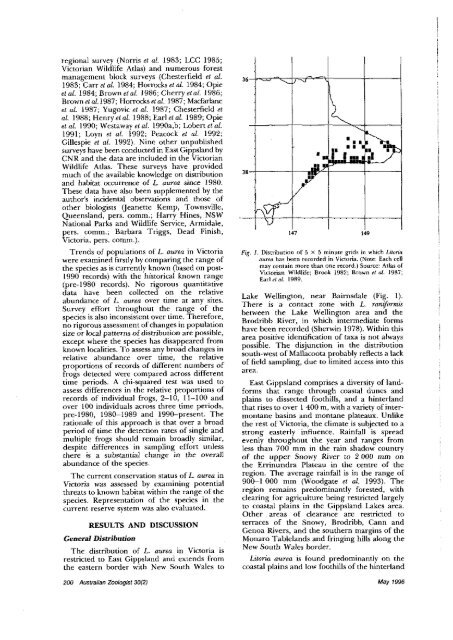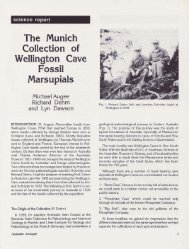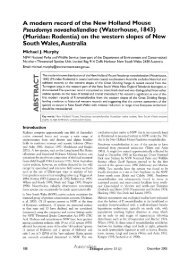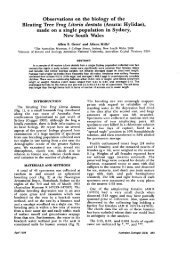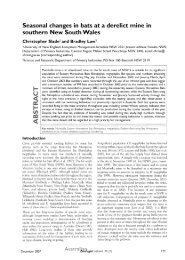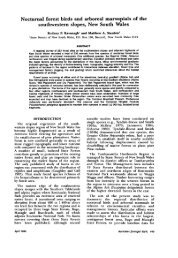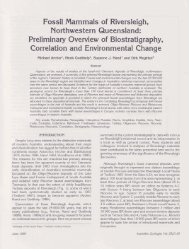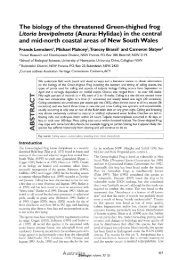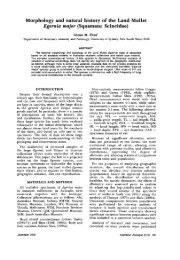Gillespie G R Distribution, habitat and conservation ... - RZS of NSW
Gillespie G R Distribution, habitat and conservation ... - RZS of NSW
Gillespie G R Distribution, habitat and conservation ... - RZS of NSW
Create successful ePaper yourself
Turn your PDF publications into a flip-book with our unique Google optimized e-Paper software.
egional survey (Norris et ul. 1983; LCC 1985;<br />
Victorian Wildlife Atlas) <strong>and</strong> numerous forest<br />
management block surveys (Chesterfield et al.<br />
1983; Carrel al. 1984; Horrocks et al. 1984; Opie<br />
et al. 1984; Brown el al. 1986; Cherry et al. 1986;<br />
Brown el al. 1987; Horrocks et al. 1987; Madarlane<br />
et ul. 1987; Yugovic et al. 1987; Chesterfield et<br />
al. 1988; Henry el al. 1988; Earl et al. 1989; Opie<br />
et al. 1990; Westaway el al. 1990a,b; Lobert et al.<br />
1991; Loyn et al. 1992; Peacock el al. 1992;<br />
<strong>Gillespie</strong> et al. 1992). Nine other unpublished<br />
surveys have been conducted in East Gippsl<strong>and</strong> by<br />
CNR <strong>and</strong> the data are included in the Victorian<br />
Wildlife Atlas. These surveys have provided<br />
much <strong>of</strong> the available knowledge on distribution<br />
<strong>and</strong> <strong>habitat</strong> occurrence <strong>of</strong> L. aurea since 1980.<br />
These data have also been supplemented by the<br />
author's incidental observations <strong>and</strong> those <strong>of</strong><br />
other biologists (Jeanette Kemp, Townsville,<br />
Queensl<strong>and</strong>, pers. comm.; Harry Hines, <strong>NSW</strong><br />
National Parks <strong>and</strong> WildliFe Service, Armidale,<br />
pers. comm.; Barbara Triggs, Dead Finish,<br />
Victoria, pers. comm.).<br />
Trends <strong>of</strong> populations <strong>of</strong> L. aurea in Victoria<br />
were examined firstly by comparing the range <strong>of</strong><br />
the species as is currently known (based on post-<br />
1990 records) with the historical known range<br />
(pre-1980 records). No rigorous quantitative<br />
data have been collected on the relative<br />
abundance <strong>of</strong> L. aurea over time at any sites.<br />
Survey effort throughout the range <strong>of</strong> the<br />
species is also inconsistent over time. Therefore,<br />
no rigorous assessment <strong>of</strong> changes in population<br />
size or local patterns <strong>of</strong> distribution are possible,<br />
except where the species has disappeared from<br />
known localities. To assess any broad changes in<br />
relative abundance over time, the relative<br />
proportions <strong>of</strong> records <strong>of</strong> different numbers <strong>of</strong><br />
frogs detected were compared across different<br />
time periods. A chi-squared test was used to<br />
assess differences in the relative proportions <strong>of</strong><br />
records <strong>of</strong> individual frogs, 2-10, 11-100 <strong>and</strong><br />
over 100 individuals across three time periods,<br />
pre-1980, 1980-1989 <strong>and</strong> 1990-present. The<br />
rationale <strong>of</strong> this approach is that over a broad<br />
period <strong>of</strong> time the detection rates <strong>of</strong> single <strong>and</strong><br />
multiple frogs should remain broadly similar,<br />
despite differences in sampling effort unless<br />
there is a substantial change in the overall<br />
abundance <strong>of</strong> the species.<br />
Fig. I. <strong>Distribution</strong> <strong>of</strong> 5 X 5 minute grids in which Liforia<br />
aurea has been recorded in Victoria. (Note: Each cell<br />
mav contain more than one record.) Source: Atlas <strong>of</strong><br />
~i;mzan Wildlife; Brook 1982; ~iown el 01. 1987;<br />
Earl el al. 1989.<br />
Lake Wellington, near Bairnsdale (Fig. 1).<br />
There is a contact zone with L. ranijormis<br />
!<br />
between the Lake Wellington area <strong>and</strong> the<br />
Brodribb River, in which intermediate forms<br />
have been recorded (Sherwin 1978). Within this<br />
i<br />
area positive identification <strong>of</strong> taxa is not always<br />
I<br />
possible. The disjunction in the distribution<br />
south-west <strong>of</strong> Mallacoota probably reflects a lack<br />
<strong>of</strong> field sampling, due to limited access into this<br />
area. !<br />
East Gippsl<strong>and</strong> comprises a diversity <strong>of</strong> l<strong>and</strong>forms<br />
tbat range through coastal dunes <strong>and</strong><br />
plains to dissected foothills, <strong>and</strong> a hinterl<strong>and</strong><br />
tbat rises to over 1 400 m, with a variety <strong>of</strong> intermontane<br />
basins <strong>and</strong> montane plateaux. Unlike<br />
the rest <strong>of</strong> Victoria, the climate is subjected to a<br />
strong easterly influence. Rainfall is spread<br />
evenly throughout the year <strong>and</strong> ranges from<br />
less than 700 mm in the rain shadow country<br />
<strong>of</strong> the upper Snowy River to 2 000 mm on<br />
the Errinundra Plateau in the centre <strong>of</strong> the<br />
regi0n. The average minfal' is in the<br />
90&1 000 mm (Woodgate et al. 1993). The<br />
"%ion remains predominantly forested, with<br />
The current <strong>conservation</strong> status <strong>of</strong> L. aurea in<br />
IJictoria was assessed by examining potential<br />
threats to known <strong>habitat</strong> within the range <strong>of</strong> the<br />
species. ~ ~ ~ <strong>of</strong> the ~ species ~ in the ~ clearing ~ for ~ agriculture t being ~ restricted t i largely ~ ~<br />
current reserve system was also evaluated. to coastal plains in the Gippsl<strong>and</strong> Lakes area.<br />
Other areas <strong>of</strong> clearance are restricted to<br />
RESULTS AND DISCUSSION<br />
terraces <strong>of</strong> the Snowy, Brodribb, Cann <strong>and</strong><br />
Genoa Rivers. <strong>and</strong> the southern mareins <strong>of</strong> the<br />
General <strong>Distribution</strong> Monaro ablel l<strong>and</strong>s <strong>and</strong> fringing hill:along the<br />
The distribution <strong>of</strong> L. aurea in Victoria is<br />
restricted to East Gippsl<strong>and</strong> <strong>and</strong> extends From<br />
the eastern border with New South Wales to<br />
New South Wales border.<br />
Litorin aurea is found predominantly on the<br />
coastal plains <strong>and</strong> low foothills <strong>of</strong> the hinterl<strong>and</strong><br />
200 Australian Zoologist 30(2) May 1996<br />
!


